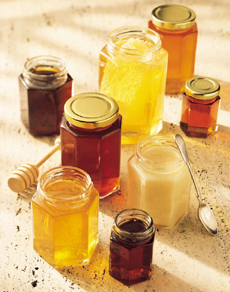

An assortment of varietal, comb (yellow jar at top), and whipped (with spoon) honeys. Photo courtesy of National Honey Board.
February 2005
Updated September 2008
|
 |
Types of Honey
Page 2: Types Of Honey
This is Page 2 of a four-page article. Click on the black links below to visit other pages.
Types Of Honey Based On Processing Techniques
-
Blended honey is a combination of honey from different floral sources—e.g. alfalfa, wildflowers, clover. Blending is done with the more commonly available and less distinctly flavored honeys to create a common denominator flavor profile for mass-merchandising. The result tends to be “sweet” and “honey” without any other flavor characteristic. The opposite of blended honey is varietal honey (see below).
- Raw honey is unprocessed. It is honey as it exists in the beehive or as obtained by extraction, settling or straining without adding heat (pasteurization). Raw honey contains some pollen and may contain small particles of wax. Raw honey comes out of the comb and go into the bottle: it is one of the purest foods on the table.
-
Strained honey or filtered honey has been passed through a mesh filter to remove particles (pieces of wax, e.g.) without removing pollen. It has a cloudy appearance due to the included pollen, and tends to crystallize more quickly than ultrafiltered honey. Popular with health food buyers.
-
Ultrafiltered honey is processed by very fine filtration under high pressure to remove all extraneous solids and pollen grains. Ultrafiltered honey is very clear and has a longer shelf life, because it crystallizes more slowly. Preferred by the supermarket trade.
- Pasteurized honey. Supermarket honey is often pasteurized to help prevent crystallization on the shelf. Crystallization is not harmful; the crystals will dissolve in the microwave (heat for 30 seconds) or in a pan of hot water (10 to 15 minutes).
- Varietal or monofloral honey comes from a single flower, e.g. orange blossom, lavender, sage. In addition to the flavor of the honey, it will express secondary flavor characteristics of the lavender, sage, raspberry, et al, and the better honeys will have complex tertiary flavors as well. The opposite of varietal honey is blended honey.
Continue To Page 3: Forms Of Honey
Go To Article Index Above
Honey definitions ® © National Honey Board. Additional material © Copyright Lifestyle Direct, Inc. Images are copyright of their respective owners. |


